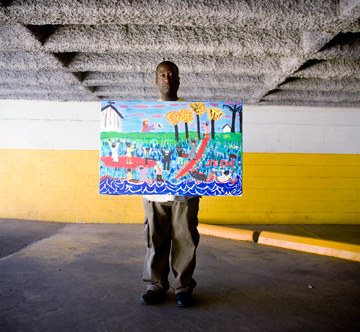The tables touch, end to end, arranged in a square that rims the room. He likes the corner, unattached, his easel angled to catch the light from the window at his back. Cornelious Brackens Jr. lifts his brush from an aluminum pan of paint and dabs it carefully onto the canvas in front of him, then onto his apron, then back. Fire-orange and red dots form leaves against a turquoise sky. He slants his head slowly for a sidelong look, moving as if through still water. “I am so deep in thought, people could be calling my name and I don’t hear them,” Brackens says later. “I forget the world.”
For as long as the studio is open, he paints. Then he goes home. But not to a house or an apartment or even a friend’s sofa. Home is the Union Gospel Mission, a shelter on Irving Boulevard. He has a bed, the top bunk, and a locker. “The people are the same. It doesn’t change much,” says Brackens, 41. “There are rules and order. With a hundred men in a room, I like that. I like the discipline.”
His landing at the mission, and the discovery of a latent talent, reads like an O. Henry tale. Though homeless, this delightful man realizes that he has lit upon a passion that he might have never known had all gone according to plan. It is the possibility that the pursuit creates that makes the bunk bed not so stiff, the crowded bathroom navigable. Dinner at the shelter tastes good.
“I have taken a funny path to get here,” he says, digging in a box for a tube of magenta. “I feel like it’s a calling for me. Everything else failed. Here, I have gained success.”
Brackens had a fortunate life as a kid in West Dallas. The eldest of three, he had two parents at home, both with reliable jobs and expectations for their children. He attended the High School for Health Professionals and planned to work in a hospital. His sister is now a nurse’s aide; his brother, a department store warehouse clerk. Their parents divorced when they were grown. Following high school, Brackens enlisted in the U.S. Army. He was stationed for three years at Fort Sill, Oklahoma, where he trained as a telephone operator. In retrospect, he may have fared better in health care.
“It was like living in prison,” he says, holding his brush in mid-stroke. “Do this, do that. It plays with your mind. It left me emotionally drained, and when I got out, I was in no shape to deal with life, with anything.” Brackens thought he’d find direction in the military. Instead, he lost his way. “Tools to prepare? Not in my case. Not in a lot of people’s cases.”
He has painted a self-portrait, in full khaki uniform, important-looking and proud, at first glance. He’d rather, though, tell stories of the people he imagines. Vivid lime grass shoots up from the bottom of this canvas, where, in the center, figures of two women begin to emerge.
When he returned to Dallas after his service, Brackens took various low-paying jobs. He worked in restaurants. He was an overnight security guard. He managed to earn enough to rent a room for a while. Ultimately, he couldn’t keep up with the payments and chose to live on the streets. “My family tried to find me and take me home. I have a good family that wanted to help. But I guess I didn’t want to accept it.”
For six years, Brackens stayed in North Dallas, earning money by working odd jobs every so often. He spent most of his time in parks, sleeping on benches, traveling light. “I didn’t have many things,” he says. Access to food and clothing was limited north of the city, and he had it in mind to make it to the city’s center. “I’m kind of shy,” he says. “So it took me pretty long to come downtown. I was too embarrassed to ask people about how to survive here.” Soon after arriving, he heard about the bus to the shelter. And then, the studio.
The first day a person comes to the door, Cynthia Brannum hands him a sketchbook and asks him to be more observant when he is out and about and to draw what he sees. “I gave Cornelious a pad when he came in three years ago,” she says. “The next day, it was completely full.”





